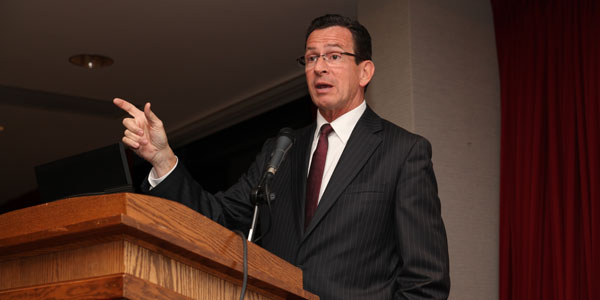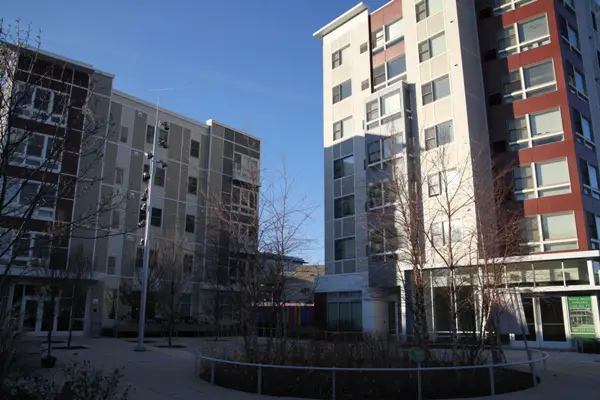
Gov. Dannel P. Malloy and business leaders are hoping to turn Connecticut”™s spotty jobs record into a steady growth trajectory.
Through October, Connecticut has recovered some 30,200, or 25.7 percent, of the 117,500 jobs lost from March 2008 to February 2010, and over the first 10 months of this year, Connecticut employers have created 1,400 net positions compared to 12,000 that were created over the first 10 months of 2011.
Seasonally-adjusted employment data show there are about 30,000 fewer Connecticut residents employed as of October than there were in 1989, according to the state Department of Labor.
Business leaders and government officials convened Nov. 20 to discuss various programs and initiatives aimed at spurring job growth as part of a “State of the State” symposium held at Fairfield University.
“At a time in our country”™s history when 23 million jobs were created, 47 or 48 states shared in the creation of those jobs,” said Gov. Dannel P. Malloy, who delivered the keynote address. “Our state did not.”
The event was hosted by the Connecticut Turnaround Management Association, a nonprofit dedicated to corporate renewal and turnaround management, in partnership with the Connecticut Chapter of the Association for Corporate Growth, Crossroads Venture Group and the Connecticut Technology Council.
As the state continues to grapple with budgetary issues in the midst of a prolonged economic slowdown, Malloy said his top priority in 2013 is to boost job growth.
Questioned about the $365 million projected deficit for the 2013 fiscal year, Malloy said the gap was largely due to increases in Medicaid due to long-term unemployment.
On Nov. 28, his administration released a list of $170 million worth of spending cuts primarily targeting social service agencies, state employee health services and higher education funding.
Next month the legislature is expected to make the remaining $200 million in cuts.
“We have to reduce the projected expenditures,” Malloy said. “That”™s what we have to do and that”™s what we”™re going to do. We have to close the year in balance.”
During the past budget cycle, Malloy closed the budget gap ”“ while restructuring the state”™s unfunded employee pension system and rainy day fund ”“ through spending cuts and tax increases.
This time around, however, Malloy insists there will be no new tax increases.
“We”™re trying to right this ship,” he said. “I”™m trying my hardest.”
Turning to the economy and unemployment, Malloy said much of what has been done has been a down payment on the state”™s future. Malloy, along with a number of the panelists who spoke during the symposium, emphasized the need to invest in growing companies and support the state”™s entrepreneurs as a strategy for creating jobs.
The state”™s First Five and Next Five programs, which offer companies tax credits and other incentives, have garnered nine pledges from companies to relocate to or stay in Connecticut and create at least 200 jobs apiece within five years.
Panelists also cited the state”™s film tax credit ”“ which several speakers said have helped create a vibrant entertainment industry ”“ and the Connecticut Bioscience initiative, which speakers said is beginning to position the state as a leader in the emerging field.
The University of Connecticutis also assisting with the latter two efforts by training its students for those fields specifically.
“Government is really being much more strategic now and I think all of us in public policy are delighted to see that,” said panelist Matthew Nemerson, CEO of the Connecticut Technology Council. “Government can”™t really create jobs but what it can do is create an environment where more capital can come in ”“ where you can borrow more money.”
Additionally, panelists discussed several new initiatives being spearheaded by Connecticut Innovations (CI) that have recently been launched to support the state”™s budding entrepreneurs.
Formed by the state legislature in 1989, CI helps support emerging high-tech companies with strategic capital. Through its investments, it has brought in over $510 million in Gross State Profit since its inception and contributed to the creation of thousands of full-time positions.
In October, CI and the state Department of Economic and Community Development launched the Connecticut Ecosystem with $5 million in state grants to help entrepreneurs grow their companies by providing access to specialized tools and capital.
One of the ecosystem”™s four hubs will be located in Stamford and run from the Stamford Innovation Center, which officially launched in November. Within the Innovation Center”™s first unofficial year, the startup incubator has helped jumpstart more than a dozen businesses through it collaborative workspace and programs.
“If you start here you need to be able to stay here,” said Chris Bruhl, a panelist and CEO of the Business Council of Fairfield County, which will collaborate with the Innovation Center to oversee the Stamford hub. “The state needs you to grow.”



















